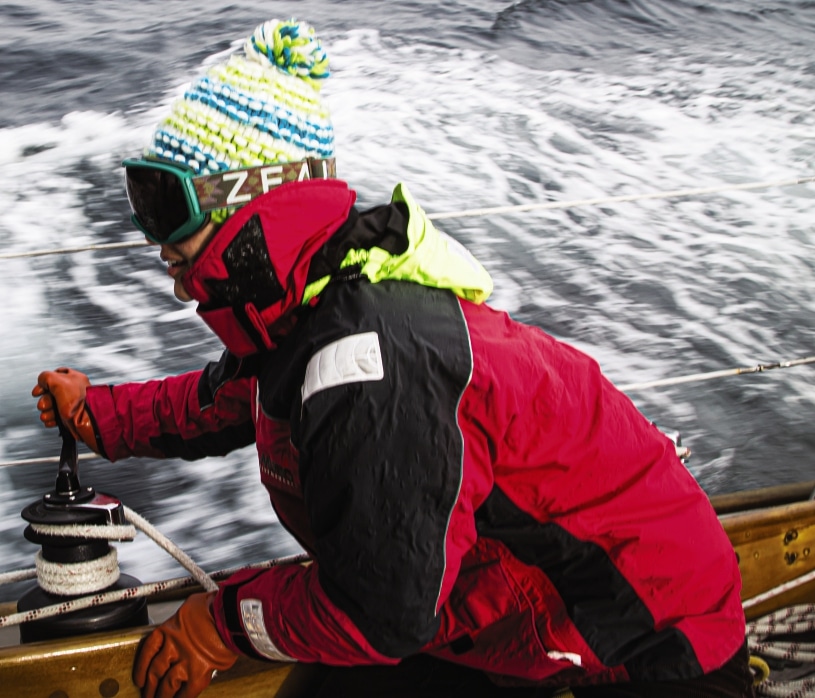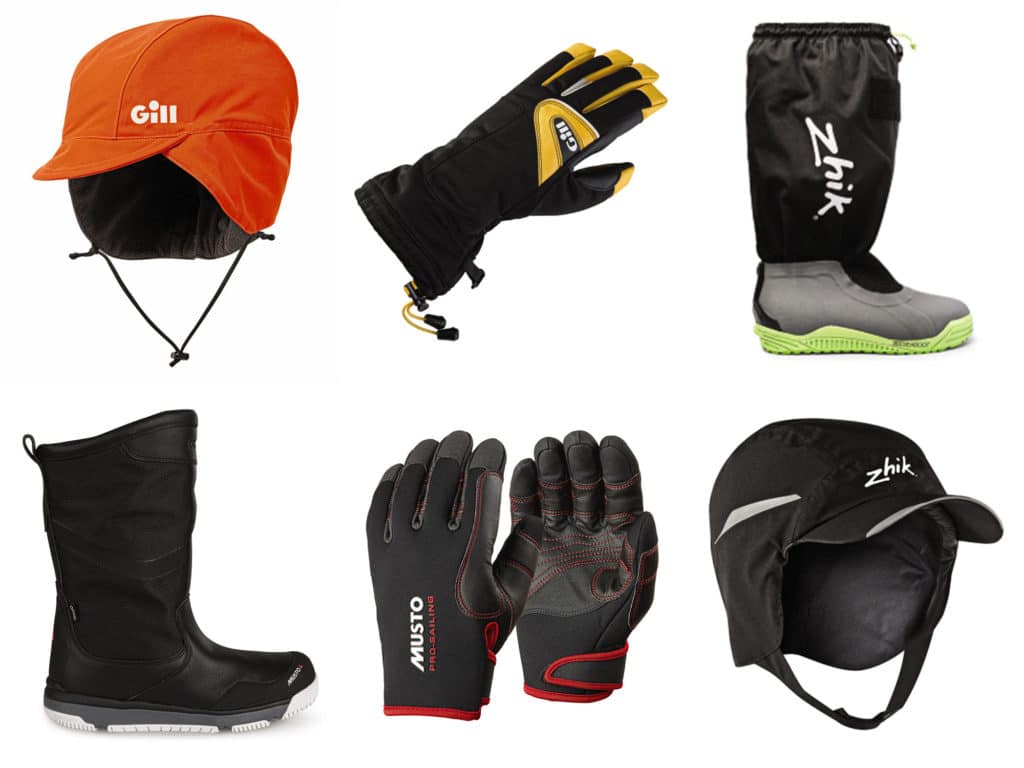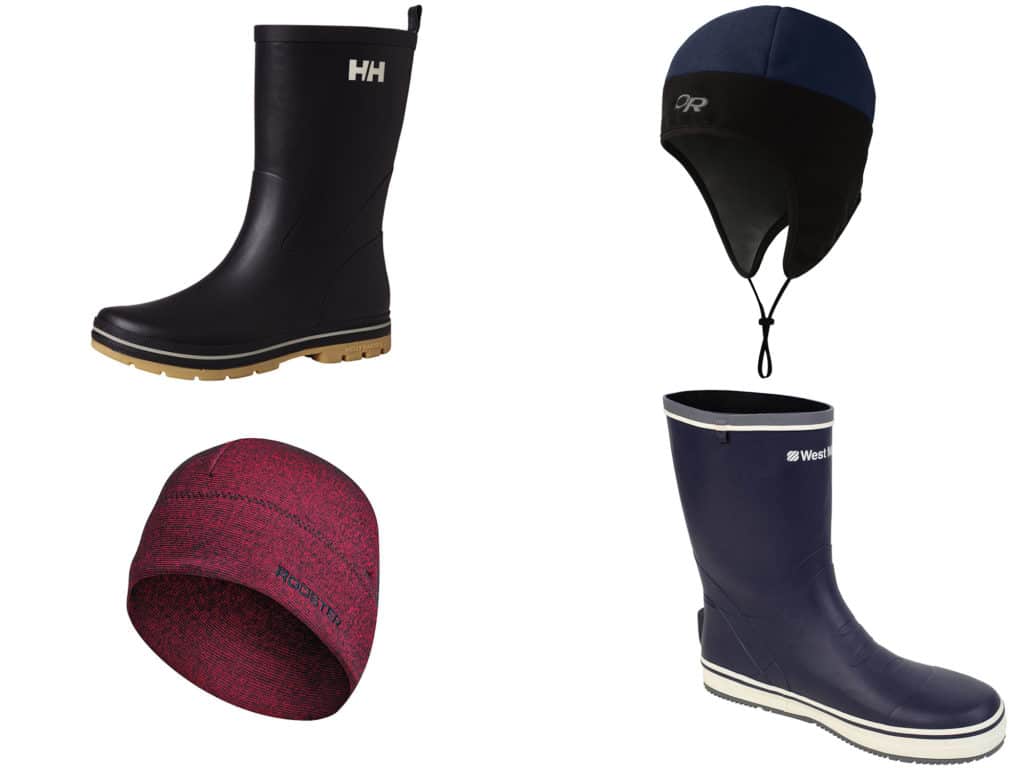
I knew it was time to replace my beloved Dubarry Ultima sea boots when, after 12 years, the sole started peeling off. Trouble was, it unfurled during a wet and cold race on Puget Sound in March. But, being a cheap Yankee, I spent the next year rehabilitating them with Shoe Goo (not the manufacturer’s recommended fix), each time with diminishing marginal returns. Finally I broke down and went to my local chandlery. Decades of every-other-day running turned my feet into embarrassing-looking paddles, and while brand loyalty guided me toward a new pair of Dubarry Ultimas, the salesman instead recommended a beamier-looking pair of Musto Gore-Tex race boots. While I was initially skeptical, my Hobbit-like feet felt warm and happy in the showroom.
Forty-eight hours later, I sea-trialed my new nautical armor during an early January blustery sail. Air temps hovered in the mid-30s, but my feet stayed warm and dry, as did the rest of me. Lesson learned? While frugality has its merits, having the right boots, gloves and hats is critical if you’re foolhardy enough to sail on days when smarter people go skiing. Here’s a look at cold-weather kit to help you stretch your sailing season.
Head Heaters
Depending on conditions, hats often need to serve double duty by providing warmth and sun protection. Gill’s OS waterproof hat accomplishes these jobs while offering waterproof protection. The fleece-lined hat features a sun-cutting visor with a wired peak, ear flaps and seam-sealed construction. You can adjust the hat’s volume using a pull adjustment, and the hat’s chin strap is conveniently removable.
Baseball caps work great in the summer, but shoulder-season and winter sailing usually demand more warmth. Musto’s fleece-lined waterproof cap employs a heat-retaining fleece lining and fold-down flaps for trapping body heat from the back of your neck and ears. A peaked visor stands ready to shade your eyes on sunny days while also providing drizzle or snow protection.
Wind might be one of sailing’s most important ingredients, but it’s also alarmingly efficient at robbing warmth on blustery days. Enter Outdoor Research’s Peruvian hat, which is built using Gore-Tex’s Infinium wind-stopper 3L fleece fabric for heat retention and wind protection. The Peruvian hat features a four-panel crown construction, a fixed chin strap and the ability to wick moisture on damp days.
Sailors have long embraced beanies as noggin covers thanks to their form-fitting profiles that can’t easily be blown overboard. Rooster Sailing’s Supertherm beanie is constructed using a soft and stretchy fabric that’s doubled around the forehead and ears to retain heat, while its top employs a single-ply fabric to encourage thermal shedding after grinding in an overlapping headsail or pulling up an anchor.
Cold-weather sailing often involves precipitation, but Zhik’s winter hat has you covered. The dome warmer is built using Zhik’s three-layer Aroshell outer fabric and Xeflex insulated lining, and employs fully sealed seams to help repel water. Ear flaps retain heat, an adjustable rear bungie cord ensures fit, a chin strap keeps the hat in situ, and reflective detailing helps ensure visibility.

Hand Warmers
While Atlas’ 460 Vinylove insulated gloves aren’t marine-specific, I’ve long used them to keep my hands warm when temperatures plummet or when the skies deluge. The all-purpose, affordable gloves feature a utilitarian design that includes a double-dipped PVC coating for waterproof protection and a seamless acrylic-pile lining for warmth. The gloves deliver great grip and are comfortable to wear for hours on end, but their weak spot is that they can be tough to don if your hands get wet.
Good cold-weather sailing-specific gloves need to insulate and provide waterproof protection while also allowing your hands to breathe after grinding in sails. Gill’s Helmsman gloves employ a breathable soft-shell fabric that’s reinforced with a waterproof and breathable membrane, as well as Thinsulate insulation on the backs; the palms and the articulated fingers use Gill’s Dura-Grip fabric for line-clutching grip. The Helmsman gloves feature extended wrist gauntlets to ensure compatibility with foul-weather jackets, and the cuffs are elasticized and reinforced with drawcord closures.
Neoprene has long been used as a heat-trapping fabric for cold-weather sailing endeavors, and this material gets put to good use in Gill’s neoprene winter gloves. The season-stretching gloves feature 3-millimeter, double-lined neoprene and liquid-taped seams to offer water-resistant protection, and the rubberized, sharkskin-style palms are designed to provide great halyard- and line-grabbing grip when on-deck conditions get sloppy. Better still, the gloves’ neoprene construction should help to ensure dexterity while working halyards, spinning winch handles or driving on cold days.
If you’re looking for winter sailing gloves that offer similar levels of performance as your summer pair but with closed fingertips and extra warmth, Musto’s Performance winter gloves could be your ticket. The gloves employ heat-trapping neoprene that’s reinforced on the palms and fingers with Clarino PU synthetic leather for rope-gripping traction. Better still, the back of the hands and wrists are double-lined with neoprene for warmth, and the fingers are articulated (that is, pre-curved) for improved comfort and dexterity.
High-performing winter sailing gloves should provide dexterity for tying knots and working shackles, while also delivering wind-chill protection and warmth. Rooster Sailing’s Combi fingered gloves accomplish this with neoprene gloves that are reinforced with Super Grip palms and have tuck-away Aquafleece overmittens. This innovative mitten folds back to accept a back-of-the-hand hand warmer, or to tuck away the finger hood. While the gloves are warm, the Aquafleece mittens deliver a wind-cutting polyurethane outer layer that’s fleece-lined for extra insulation.
Grippy, stretchy and warm. These adjectives describe Zhik’s Superwarm gloves, which—as its name implies —is designed to deliver warmth, stretchy comfort and line-grabbing grip on the coldest of days. The gloves are built out of 3-millimeter thermal neoprene using seams that are glued and blind-stitched for additional waterproof protection. Zhik’s Superwarm gloves are fleece-lined for additional warmth and feature polyurethane-reinforced palms with a studded pattern for additional grip. Better yet, the gloves purportedly deliver move-with-you ergonomics thanks to their pre-shaped pattern.
Toe Toasters
Dubarry’s Ultima sailing boots are, in a word, classic. There’s a good reason that the footwear is the go-to choice for many top offshore racers and bluewater cruisers, which is namely the boot’s all-leather exterior; its warm, waterproof and breathable Gore-Tex lining; and Dubarry’s nonslip, nonmarking sole. Moreover, the boots allow your feet to breathe, which is a huge plus if your on-deck work involves occasional bursts of sweat-inducing efforts on the winch handles or halyards. As mentioned, I’ve personally sailed many happy miles in my old pair of Ultimas, including countless winter days on Puget Sound, and I always appreciated the boot’s performance, comfort and stylish good looks.
If your sailing itinerary demands count-on-it waterproofness but you’d rather contribute your hard-earned coin to the cruising kitty than to your footwear, Helly Hansen’s Midsund 3 boots could be a contender. These Wellington-style boots consist of rubber uppers and grippy-looking lug-style rubber outsoles that are sandwiched together using a rubber midsole and wrapped in yet more rubber to ensure waterproofness. Foot support comes courtesy of EVA insoles, however cruisers can swap these out for aftermarket orthotics. A pull tab on the back of the boot’s upper eases the job of donning these boots, which are stylish enough to wear ashore after a day of sailing.
While I might be a pinch biased, given that I own a pair of Musto’s Gore-Tex race boots, I think that these are sea boots that—if they fit your foot—work really well. The boots are built using full-grain leather and ballistic nylon uppers, as well as rubberized toe boxes that protect your toes from inadvertently dropped snatch blocks and winch handles and accidental stubs. The boots feature a comfortable and shock-absorbing midsole, as well as Musto’s GripDeck rubber and GripFlex tread on the soles, ensuring steady and dependable footing, even if the foredeck or rails are submerged. Finally, a Gore-Tex lining ensures breathability and count-on-it waterproofness.

If you live in a region that has relatively mild shoulder-season and winter temperatures and want an agile, lightweight and comfortable-looking sailing boot, check out Ronstan’s offshore boots. These kicks are cut shorter than most of the other boots in this article, but they feature toggle-locked drawstrings around their apertures that help prevent water from entering or hard-won heat from escaping. Ronstan’s offshore boots feature waterproof rubberized outers and neoprene linings for warmth and comfort, as well as razor-cut soles for deck-grabbing traction. Removable insoles allow the boots to dry quickly, and reinforced materials on the boots’ toe boxes, ankles and heels protect cruisers from “boat bites.”
While wind and water might be free, most everything else sailing-related, sadly, isn’t. If your goal involves maximizing cruising miles while minimizing elective costs, West Marine’s short rubber deck boots could be a good fit. As their moniker implies, the boots are built from vulcanized rubber. Polyester lining helps ensure fast-drying performance, and reinforced heels and toe boxes bolster support. The boots feature rubberized heel kicks on their transoms that purportedly make post-sailing removal a snap. Finally, razor-cut soles help ensure grip, while ergonomically placed flex grooves in the soles are designed to enable the boots to freely move with you, sans unwanted stiffness.
If you’ve cruised Alaska’s magnificent waters, odds are good that you’ve seen Xtratuf’s iconic-looking boots adorning the feet of local fishermen and sailors. Xtratuf’s 15-inch Legacy 2.0 boots are built using triple-dipped latex, and they’re lined with neoprene—making them fully waterproof—and employ nonmarking and slip-resistant Chevron outsoles that help ensure steady footing. Additional layers of rubber on the shins and extended toe boxes help prevent abrasion-created wear, and the boot’s top line dips in the back to prevent chaffing against the back of one’s calf. Other features include textured heel finishes for easy removal and a polyurethane-lined rim for abrasion resistance.
You’ve seen the photos: Volvo Ocean Race boats punching through waves, filling their cockpits with frigid-looking brine. If you’re seeking the kind of waterproof protection that the racing sailors demand, check out Zhik’s Seaboot 900, which was designed for—and tested in—this grueling around-the-world race. The rubber boots are neoprene-lined and feature integrated nylon outer gaiters that are secured with drawstring-protected tops and Velcro adjusters. High-grip molded rubber soles purportedly help wearers maintain their traction in all conditions, and reinforced arch and heel sections provide support and help prevent injuries. Each boot is individually tested during Zhik’s manufacturing process to ensure fully waterproof performance.
David Schmidt is CW’s electronics editor and occasionally reports on other topics.
Heat Helpers
While I’ve long enjoyed winter sailing, I struggle with Raynaud’s phenomenon, which results in miserably cold hands when I’m required to touch metal shackles, stanchions or spars. As such, I always pack a surplus supply of hand warmers from companies including Hot Hands and Grabber. These tidy-size heat sources are inexpensive (roughly $1 a pair), long-lasting, and can be tucked into gloves or pockets. Likewise, toe warmers are available that can be deployed inside sea boots.
Guide To Manufacturers
Dubarry: dubarry.com
Helly Hansen: hellyhansen.com
Gill: gillmarine.com
Musto: musto.com
Outdoor Research: outdoorresearch.com
Ronstan: ronstan.com
Rooster Sailing: roostersailing.com
Showa (Atlas): showagroup.com
West Marine: westmarine.com
Xtratuf: xtratuf.com
Zhik: zhik.com








